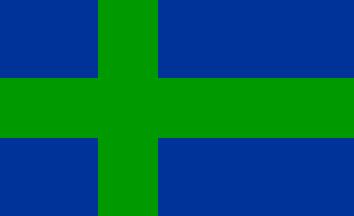
Last modified: 2007-04-14 by antónio martins
Keywords: vaddjamå | vod | votia | votic | cross: scandinavian (green) | valoczy ferenc |
Links: FOTW homepage |
search |
disclaimer and copyright |
write us |
mirrors

This flag is completely unofficial. I designed this flag for use on
the website Virtual Votia
(and, hopefully, elsewhere…) along with an orthography for the
unwritten language. The colour blue of the flag should be the same as on
the Finnish flag (on which the Votian flag is based).
The green comes from other Balto-Finnic flags —
the Vepse,
the Karelian,
the Livonian.
Valoczy Ferenc, 23 Jun 2003
I noticed the similarity between the Vepsian flag and the Votian flag. I guess the East Karelian flag is influential, too.
Theory: If the East Karelian flag is well-known in the area, the green colour could have the local connotation of Finnic peoples. And in that case, the similarity of the various flags is more or less to be expected. After all, how many different flags can you make, if you must use a green field and a Scandinavian cross?
Contra: The Ingrian flag is yellow, red and blue, and our page on pan-finnic colours seems to be mostly about shades of blue…
Ole Andersen, 26 Aug 2000
What struck me with the Votian flag, was that it rather much looked like
the Swedish flag, not only in design but also in one of
the colours. If this is intentional or not, I don’t know.
Elias Granqvist, 26 Aug 2000
This image, as any other, is just one of a wide range of variation seen
on many related sources.
António Martins, 16 Jun 2001
I checked the map
on line and it seems that all the votic population is in Russian
territory.
Dov Gutterman, 29 Aug 2000
The Votic people obviously lives in Ingria.
What is the difference between the Ingrian and the Votic languages?
Elias Granqvist, 25 Aug 2000
Vote is the earliest of the Baltic-Finnic languages;
Ingria’s variegated population has included also Ingrians,
Estonians, and above all, Finns. Vote has almost died out;
there remain a few tens of speakers, mostly elderly, the
youngest being middle-aged. In the middle of the last [i.e.,
19th] century there were still five thousand or so, but they
have assimilated to the Ingrians, Finns and Estonians.
Lewis Nowitz, 25 Aug 2000,
quoting from Maailman kielet ja kielikunnat,
by Jaakko Anhava
The Votian language is the most archaic of the Balto-Finnic languages.
There is a dictionary of the Jõgõperä dialect available
from the Suomalais-Ugrilainen Seura in Helsinki (Lexica Societatis
Fenno-Ugricae volume 25: “Vatjan Kielen Joenperän
Murteen Sanasto”). There are a few other books available on Votian,
notably Paul Ariste’s Grammar of the Votic Language (Uralic
and Altaic Series volume 68, Indiana University). The language is
basically the bridge between Estonian and Karelian, and has a very large
number of borrowings from Russian, not only lexically but grammatically as
well. Do not confuse Votes with Wotjak/Votyak, a name which
refers to the Udmurts. In Russian, Votian is
водьский, in
Novgorod times they were called чуді.
Valoczy Ferenc, 23 Jun 2003
Remnants of the original Finnish population are the Ingers
(Inkerikot) and the Woten [Votic] (Vaddjalaiset). The
first (13.800), named by the Russians also Ishortsy, after the Ishora
river, a tributary of the Newa, spread in olden days up to the southern
end of Lake Ladoga; now they live spread along the coast between
Oranienbaum [Lomonosov] and Narwa and south of that. The Woten (1000)
live only in the municipality of Kattila near Narwa; before the
immigration of the Ingers they ruled Ingtermanland and took part in the
foundation of the Varinger-realm of Novgorod. Their language is archaic
and forms the transition from Finnish and Karelic to Estonian; while the
Ingers speak a Karelic dialect mixed with Russian elements. Both peoples
used to be Lutheran, but are now members of the Russian Chrurch.
Jarig Bakker, 25 Aug 2000,
quoting from Die Völker Europas,
by Georg Buschan, c. 1910
Anything below this line was not added by the editor of this page.